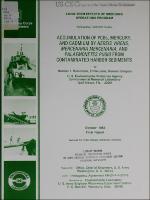Please use this identifier to cite or link to this item:
https://hdl.handle.net/11681/4858| Title: | Accumulation of PCBs, mercury, and cadmium by Nereis virens, Mercenaria mercenaria, and Palaemonetes pugio from contaminated harbor sediments |
| Authors: | Environmental Research Laboratory (Gulf Breeze, Fla.) United States. Environmental Protection Agency Long-Term Effects of Dredging Operations Program (U.S.) Rubinstein, Norman I. Lores, Emile M. Gregory, Norman R. |
| Keywords: | Bioassay New York City Harbor Contaminants Sediment Dredging Dredged material Dredging spoil Bioaccumulation Biological assay Aquatic ecology Biology Water quality Aquatic pollution Marine pollution |
| Publisher: | Environmental Laboratory (U.S.) Engineer Research and Development Center (U.S.) |
| Description: | Technical Report Abstract: Accumulation of polychlorinated biphenyls (PCBs), mercury, and cadmium by sandworms (Nereis virens), hard clams (Mercenaria mercenaria), and grass shrimp (Palaemonetes pugio) exposed to contaminated sediments from four sites in New York Harbor was studied for a 100-day period. Of the three contaminants monitored, only PCBs were found to bioaccumulate above background (control) concentrations. Small increases in PCB body burden were detected in M. mercenanria and P. pugio, whereas higher concentrations were measured in N. virens. Uptake was affected by the organic content of the sediment. Bioaccumulation factors (concentration in tissue/concentration in sediment) for N. virens ranged from 1.59 in a low organic sediment to 0.15 in a high organic sediment. Comparison of 10-day and steady-state concentrations of PCBs in N. virens indicates that a 10-day exposure underestimates equilibrium concentration; however, 10 days is sufficient to detect the potential for PCB accumulation. Results from this study support the contention that sediment concentration alone does not reflect bioavailability and that toxicity tests (bioassays) and field monitoring remain the most direct methods for estimating bioaccumulation potential of sediment-bound contaminants. |
| Rights: | Approved for public release; distribution is unlimited. |
| URI: | http://hdl.handle.net/11681/4858 |
| Appears in Collections: | Technical Report |
Files in This Item:
| File | Description | Size | Format | |
|---|---|---|---|---|
| TR-D-83-4.pdf | 8.46 MB | Adobe PDF |  View/Open |